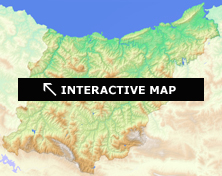First settlers
Lower Palaeolithic
The oldest human remains date back almost 200,000 years and were discovered in Lezetxiki and nearby caves in the Alto Deba. As well as human and animal remains, tools and ornamental objects were found. The plentiful local supply of flint to fashion weapons and tools influenced where people settled. The climate would have been much as it is now, Atlantic and mild, dominated by oak and other deciduous woodland, inhabited by deer, bison, horses and bears. But there were also cold spells, the glaciations, when there were animals such as the shaggy rhinoceros, when tundra prevailed and people moved down to the coast and lived in low-altitude caves.
Upper Paleolithic
The final stage of the Palaeolithic era began some 15,000 years ago, and it has left many traces in the area. As well as what were possibly more or less permanent open-air settlements, people lived in south-facing caves from which they could control hunting grounds: Aitzbitarte in Errenteria, Erralla in Zestoa, Altxerri in Aia, Langatxo in Mutriku, Ekain, Urtiaga, Ermittia, Praileaitz and Astigarraga in Deba.
World Heritage Site
Perhaps, the most interesting and revealing remains are the cave paintings at Ekain, with their magnificent horses, and the cave engravings at Altxerri, in which bison predominate, and which are not found at the entrance to the caves but well into the interior, in inaccessible areas without natural light, which seems to confirm the magical and shamanistic character of what today we call prehistoric art.
The Ekain and Altxerri caves have been both declared a UNESCO World Heritage Site.
Most interesting archaeological remains
Clicking the following interactive map will reveal the province’s most important pre-historical sites. Click on each site for further information and photos of that site.
Further information here: "The origins of art in Gipuzkoa" and "The Magdalenian pendants of the Praileaitz I cave(Deba)" (Bertan Collection).


